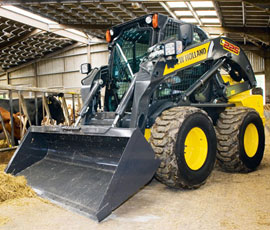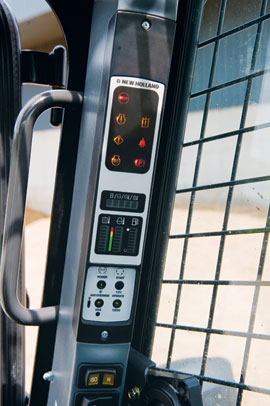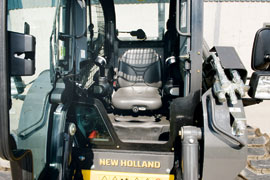VIDEO: NH new skidsteer range widens appeal

Skidsteer loaders may be popular in many countries but they’re still a niche product in the UK. Emily Padfield wonders whether New Holland’s new L200 might change some farmers’ minds.
Skidsteer loaders are one of those machines that appeal even before you get in the cab. However, the last one I drove regularly, on a dairy farm in Berkshire, was noisy, cramped and rattly, and made you feel like a hunchback when you got out after a long stint. But the sheer manoeuvrability of this type of machine makes it virtually essential when mucking out calf pens, bull housing and on daily bedding up duties.
Things have changed somewhat over the 10 years since I was working on a dairy farm. The EU has clamped down on vibration and noise levels, demanding that manufacturers improve their standards when designing these mini workhorses. However, they still largely remain the choice of small farms with narrow alleyways, barely getting a look in when farmers look at the options for a new materials handler.
Enter New Holland’s L200 Series skid steer loader. There are six models in the series, ranging from 46hp with 590kg lift to a more punchy 82hp machine that can lift a not-to-be sniffed at 1135kg to 3.3m.
The new range replaces the old L100 series. That had a parallelogram arrangement that allowed the boom to lift vertically while remaining at the same distance from the cab, but one of the main drawbacks was that the rear of the boom remained exposed.
“Other skidsteers at the time used radial booms, meaning the load got nearer to the machine as it was raised,” explains Ian Thomson of New Holland. “That made them redundant for loading trailers and similar common farm tasks.”
Now, according to Mr Thomson, farmers are starting to reconsider the humble skidsteer. “As people become more cost-conscious, the economics of a skidsteer stack up. Low purchase price, fuel use, and running costs make them a more viable option.”
In the US, Australia and Canada, skidsteers are far more commonplace, with most dairy farms having larger units to load feeder wagons, muck out and the like, he adds.
And while legislation increasingly affects telehandler operation, skidsteers’ fixed-radius format means they don’t have to comply with the new EN1100 rules. These tough regs dictate that when the operator has overloaded the muckgrab, he has to push buttons, pull levers and virtually perform an aptitude test to get the boom moving again.
Driving impression
We tested the new L225 on a Kinross-shire farm with 200 pedigree Holsteins, so had plenty of muck to handle and pallets of minerals to unload.
Looks-wise, the boom is now 100% enclosed and sits low at the back for increased visibility, giving the new L200 a sleeker look. The tyres are beefier too, and the enclosed climate-controlled cab offers a choice of switching between left- and right-hand joystick controls.
Getting in is the usual rigmarole of clamouring over the front of the boom, however once in there’s a sturdy door that separates you from the often dusty and dirty environment outside. Noise has also been reduced, partly thanks to this almost entirely glass door.
“With some of the old cabs, it wasn’t unusual for operators to come out resembling a rabbit with myxamotosis,” says Mr Thomson. “But these new machines aren’t the narrow, cramped models from the past.”
The layout of the controls is neat, too. At first, the plethora of switches and blister buttons is a little daunting but, with the exception of a few, each is explained on a little diagram on the other side of the post.

The fully climate controlled cab on the model we tested had a keyless start, which took a bit of getting used to. Because a large percentage of these machines are destined for hire situations, New Holland has designed a system whereby operators press a number of buttons before starting the engine. Even the park brake is a blister button on the right-hand A pillar, which you have to press and hold before you can go anywhere.
There are three ranges of chassis available – narrow, standard and wide. The L225 was the wide spec with a four-cylinder 82hp Fiat Powertrain engine – plenty punchy enough for the range of tasks we set it to. A full muck grab was easily handled, even while scaling the muckheap itself.
For those who are used to operating a telehandler, the right-hand joystick has been designed to work in the same way, whereas the left hand denotes the direction and speed at the machine. A foot throttle controls revs, and there’s a hand throttle to help with powered implements, too.
On the headstock, there’s enough hydraulic services to satisfy any user, thanks to the fact that these machines are often used for road duties which require three or four services. There’s even an electric coupling should you need it. Hydraulic flow is 72 litres as standard on smaller models and 85 litres on the larger two models. The high-flow option gives an extra 36 litres on smaller models and 46 litres on larger ones.
Visibility, once you’ve remembered that you’re in a fairly compact machine, is pretty good, despite the guards either side of the windows. To the front, nothing obstructs view – just remember not to lean forward too much or you’ll headbutt the window.
 Back to the driving. Once you’re nestled in your command centre it’s almost like being in an Apollo spacecraft, with all controls positioned close to hand and within easy reach. You can even change implements from the seat (a result of the popularity of these machines in construction) and all connections are easily accessed when you hitch up. For those who don’t even want to get out to do that – it’s possible to get a hydraulic faceplate.
Back to the driving. Once you’re nestled in your command centre it’s almost like being in an Apollo spacecraft, with all controls positioned close to hand and within easy reach. You can even change implements from the seat (a result of the popularity of these machines in construction) and all connections are easily accessed when you hitch up. For those who don’t even want to get out to do that – it’s possible to get a hydraulic faceplate.
A two-range hydrostatic transmission delivers drive and top speed is 18kph. The L225 tested was road legal, but I wouldn’t suggest travelling at school time for fear of a few angry motorists.
Lights are cunningly integrated into the back end, and not mounted on brackets which could easily be bashed. At the front, they’re mounted on the usual brackets but kept away from the action.
Servicing is straightforward. The back grille opens and reveals the fuel filler, engine oil dipstick and coolant levels as well as the air filter. There’s an immobiliser on the battery, too.
To drain the engine oil you unbolt the side panel and take the battery out. To get to the engine itself, the cab lifts up (as on a lorry) a process that involves just undoing two bolts.
Our verdict
A no-nonsense, compact and capable machine, ideal for getting round tight buildings but equally at home in large airy sheds, the L225 is certainly worth a look at if you’re pondering ways of cutting purchase and running costs.
L225 Skidsteer
• Power: 82hp
• Lift capacity: 1,135kg
• Lift height: 3.3m
• Price: £35,892

